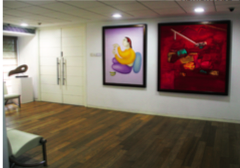Info
Godrej: Corporate and institutional art collections | Mumbai Mirror

 By Mortimer Chatterjee
By Mortimer Chatterjee
Published in Mumbai Mirror | 16 November, 2015
Dr. Pheroza J. Godrej has played an integral role in the city’s art scene for more than forty years. She is internationally acknowledged as both a connoisseur of the arts and an art historian, with a remarkable ability to shift registers between the public and private. At the level of policy and headlining initiatives, she was, until very recently, the Chairperson of the Advisory Board of the National Gallery of Modern Art, Mumbai. She is presently on the Executive Committee of the National Culture Fund, Ministry of Culture; a trustee of the Indira Gandhi National Centre for the Arts, New Delhi; the Honorary Secretary of the Museum Society of Bombay and founder of one of the city’s longest running galleries. As an enthusiastic and serious collector of art, she has built an enviable collection, The Jamshyd & Pheroza Godrej Art Collection. This collection, like others started during the first few decades after India’s Independence, reflects an individual’s taste writ large over an organization.
The initial spurt in acquisitions was due, in large measure, to Dr. Godrej’s establishment of Cymroza Art Gallery, in 1971. This was the main source for many of the paintings that came to form the collection. The philosophy that inspired her was simple; if she believed in an artist enough to select him/her to exhibit at her gallery, then she felt compelled to support this belief by personally acquiring the artist’s work.
The inevitable consequence of continued acquisitions was the loan initiative to Godrej offices around the country. Initially, this dispersal was restricted to contemporary prints (the collection represents one of the strongest in the region). The project met with much success and was subsequently broadened to include oil on canvas and works on paper. Those in charge of branch offices countrywide were encouraged to select artworks from the collection for display at their workspaces. The key factor when selecting works for display was to gauge whether a lay art-enthusiast would relate to a particular work.
Dr. Godrej’s office is located in Godrej Bhavan, in the Fort area of Mumbai (the building’s architecture is itself worthy of note). Her office walls are covered by paintings that hang, salon style, one above another. As she says apologetically, “I have not been very disciplined myself of what I put up, and don’t put up”. However in important public spaces, especially at Godrej Bhavan, Dr. Godrej takes great personal interest in the display of art works, and it is here that some of the masterpieces of the collection reside, including examples by Manjit Bawa, Jehangir Sabavala, and N. S. Bendre – as also a number of fine classical Indian sculptures.
Beyond acquiring art, there has been a long-standing attempt to engage local communities, especially those living and working at Pirojshanagar – the Godrej industrial garden township in Vikhroli. In the late 1970s Haku Shah, the famous Ahmedabad-based artist, was invited to conduct art camps for children attending the Godrej Udayachal School. Along with Dr. Godrej, this project had the support of family members Smita Vijay Crishna and the late Soonu Naval Godrej. Named ‘Creativity and Hands’, it also involved Madhubani artists as mentors. Whilst similar art camps continued, the company also took on an artist-in-residence, Mr. Mangutka from M. S. University, Baroda, and a pupil of the renowned sculptor Sanko Chaudhuri.
In 2015, the artist-in-residence program has been given a new lease of life by a team comprising Jamshyd and Pheroza Godrej’s son, Navroze Godrej, and the Godrej Innovation Centre and Godrej Archives. The first artist to be invited has been a California- based artist, Jeremy Meyer, who exclusively works with typewriters as his medium. Using the parts sourced from the classic and historic Godrej ‘Prima’ typewriter, the artist has created an extraordinary kinetic lotus that unfurls its petals at the beginning of the working day and closes them at the close of the day. An exciting program of events is now being developed for the residency, and this will roll out over the next year.
Dr. Godrej and Navroze have also put in place a coherent plan of conserving and cataloguing the existing art collection; for instance biographies are being compiled on lesser-known artists in the collection. In due course, it is intended that the collection becomes a resource for scholars, particularly those interested in the history of printmaking and pottery in India during the modern and contemporary eras.
